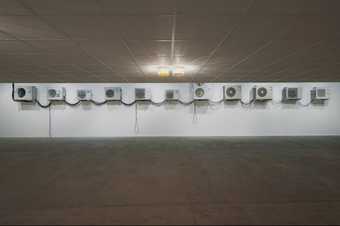This audio description is delivered in the spirit of Ima-Abasi Okon’s works. After conversations with the artist, this attempts to centre the experience of the audio describer as curious spectator, tentative critic.
I stand on a threshold, I, your audio describer, perfectly centred in the doorway of an exhibition space. This is the display of Ima-Abasi Okon’s work acquired in 2020 at Tate Britain. Before me is a large open room, 19 metres by 10 [metres]. Just under half of the space has a low, modular ceiling, which is attached to the far loftier original ceiling with steel suspension wires. Two sets of glass ceiling lights are positioned to the far left and right and beyond these are giant, wall-mounted air conditioners, connected with loops of thick power cables.
I enter the space. I look up and am confronted by the mottled bland ceiling tiles reminiscent of a doctor’s waiting room, reminiscent of a windowless office room. They’re cream in colour. I’m 5’8” or 1.7 m and I can almost touch it if I stand on my tiptoes. It feels like it’s pressing down. I feel claustrophobic. A couple of desks and swivel chairs wouldn’t look out of place here. But the floor is vast and empty. It’s just me under this oppressive ceiling.
It stretches 14 tiles by 16 tiles across and then abruptly ends. At the far end of the room, the fans within the giant air conditioners spin into action and music plays from within them. I pay them no mind. I’m not sure how to proceed so I look up and this time my attention is drawn to the first set of ceiling lights to my left, positioned towards the end of the tiles, furthest from the door.
They’re handblown crystal cut glass and look like someone’s clamped two whisky tumblers rim side up. They fit close to the ceiling with no pendant. The crystal is intricate. It bears geometric shapes, diamond motifs around the sides, sun-ray patterns at the base with a raised point in the middle. Inside is a golden-brown substance. The label tells me this is polished steel, LED lights, hand-blown lead crystal, palm oil, Courvoisier VS Cognac, 20.5 by 11 cm. It’s not the sickly white strobe lighting I’d expect to be paired with this kind of ceiling.
I can’t pin down the colour. It’s iridescent. I prowl around it, watching the colours move through different shades of brown to gold. And around it is a white halo of light refracted from the glass, the diamond motif repeated across the tiles until it peters out. These two lights are glamorous and that glamour seems to spread across the ceiling surface. I raise my hand to catch the warm glow of light and enjoy the play of patterns against my brown skin. I spend a long time under these lights and although the ceiling still seems bland, it takes on a sheen, barely perceptible in the low lighting but transformed with time.
I move to the other pair of lights to my right. They are further back towards the doorway and bear the same level of intricacy of design. These ones have a similar central focal point within a complex star pattern. Spangled specks of light are cast onto a wall to the right.
My neck hurts. I move forward finally escaping the ceiling and am suddenly struck by the miraculous deliverance of height. It’s brighter here. The original ceiling of the exhibition room is airy and high but that’s not the main focus. 11 industrial air conditioners are mounted on the wall. Five to my left. Four to my right. Two in front of me. As the fans start, music plays, following the speed and rhythm of their rotations. I let the loop of music play through, then silence. Or rather, just the gentle whir of the motors.
I move closer to investigate the great bulky machines which are more or less evenly spaced. They’re drab. Totally mundane. Some of them are scratched, dented, some of them are grimy. I wouldn’t want to touch them. They’re not new and they’ve been stripped down to just their fans and motors. They’re definitely not glamorous. I can’t ignore them because of their size: wide girths of plastic. I would go as far as calling them ugly. They’re a range of makes. Toshiba. Mitsubishi. Panasonic. Fujitsu. Fonko. Intertherm. Haier. I read the label about them. 11 stripped air conditioner inverters, 500 metres of power cables, three DMX controllers, dimensions variable. I decide to take them in one by one, moving from one machine to the next.
One has a handwritten note on the side: Defect. One has a large dent. They all bear safety labels that read: Caution, high pressure. When they start up in unison, I take the opportunity to get closer. They’re positioned just above head level and when I step nearer I can feel the gentle waft of wind against my cheek. I close my eyes and let the music wash over me.
I follow the loops of cables between each air conditioner, thick lines bunched together, hoping it will lead me somewhere. They don’t. I put my hand up to the fan, to feel the wind again and turn around to face the low ceiling, my back to the air conditioners. From this angle I’m confronted by the strange emptiness of the space and the surprising presence of those crystal lights, their opulent glow, lending the room a warmness.
Your audio describer has been Elaine Lillian Joseph.



